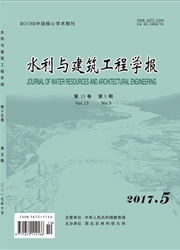

 中文摘要:
中文摘要:
水文气象预报技术的发展为水库防洪调度动态控制汛限水位提供了可能。抬高水库汛限水位可提高水库兴利效益,但有一定防洪风险。该文基于贝叶斯定理与洪水预报误差特性,提出确定汛限水位动态控制域上限的风险分析方法。以清河水库为实例,当汛限水位动态控制域上限遭遇设计频率洪水时,该文分析在不同洪水预报误差范围内,调洪最高水位超过各设计频率特征水位的概率,并应用贝叶斯定理得出各设计频率洪水发生时遭遇不同洪水预报误差的风险。结果表明,清河水库实施预报调度方式确定的汛限水位动态控制域上限127.80 m是安全的。该文提出的风险分析方法弥补了目前预报调度方式风险分析中不能直接得知不同洪水预报误差的风险的不足,充实了水库调度风险分析的理论基础,具有一定的理论意义和实用价值,可供同类型水库参考应用。
 英文摘要:
英文摘要:
The development of hydrometeorological forecast technology offers important opportunities for reservoir dynamic control of flood limited water level. Economic benefits can be improved by raising the flood limited water level, but there is certain flood control risk. The purpose of this study was to propose a risk analysis method of upper bound of dynamic control of flood limited water level in order to provide the support for the development of dynamic control of flood limited water level. The proposed risk analysis method was based on Bayes theorem and flood forecast error characteristics. Qinghe reservoir, located in the northeast of China, was taken as an example. 21 flood events of actual and forecast runoff from the year 1964 to 2013 were used. For large reservoirs that has the ability for multi-year regulation, decision makers of flood control operation concern a lot about runoff forecast accuracy because the design flood is controlled by the flood volume. First, maximum entropy method was selected to simulate the runoff prediction error probability density function of 21 flood events, also forecast error range was calculated. According to the actual need of runoff forecast error in Qinghe reservoir, the range was divided into 6 zones, and distribution probabilities of runoff forecast errors in each zone, namely the prior probability distributions of flood forecasting errors were obtained by integrating the density function. Then, the probabilities of the highest water levels being higher than corresponding designed levels within different flood forecast error bounds were studied, and the risks of different flood forecast errors were inferred by Bayes theorem when the highest water level in flood regulation met with the design flood frequency. Based on the risk analysis method, risks of each design water level considering flood forecast information were compared with risks of conventional mode. The proposed risk analysis method of upper bound of dynamic control of flood limited water level was compared with
 同期刊论文项目
同期刊论文项目
 同项目期刊论文
同项目期刊论文
 期刊信息
期刊信息
